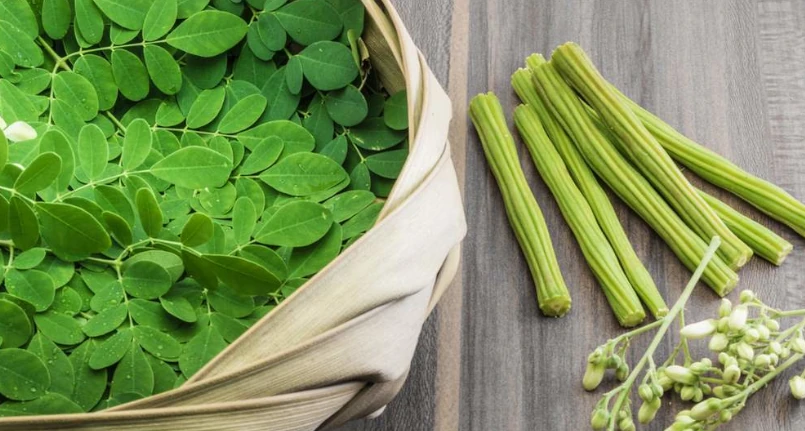What is Moringa?
Moringa oleifera is a tree native to India, Pakistan, Bangladesh and Afghanistan. It is also grown in Central America and parts of Africa. It is also known as wand tree due to the shape of its long pods . Moringa trees grow quickly and don’t need a lot of water, making them easy to grow.
Every part of this superfood is edible : leaves, roots, unripe pods, flowers and seeds. The oil obtained by pressing the seeds can be used in the kitchen and in the cosmetic field in skin and hair care products . Once the oil has been extracted, the seed hulls can be used for a water purification process called flocculation. Some edible parts of the tree can be harvested within the first year of planting a cutting.
Beneficial properties
Moringa does not owe its fame to the mere presence of nutrients , but also to the various beneficial properties for the body that are attributed to it. Going into more detail, the following are ascribed to Moringa and its extracts :
- Anti-inflammatory properties , thanks to the presence of flavonols and phenolic acids;
- Antimicrobial properties, especially against bacteria such as S. aureus, E. faecalis , E. coli and P. aeruginosa;
- Antioxidant properties, thanks to the polyphenols contained in the plant;
- Anti-hyperglycemic properties, due to the presence of terpenoids in the plant;
- Chemo-preventive and anticancer properties (the compounds responsible for such an activity would appear to be glucosinolates ).
Use in the kitchen
Moringa leaves, pods, seeds, flowers and roots are consumed as part of the normal diet in countries where it is widely grown. On a nutritional level , Moringa boasts an interesting amino acid profile , as well as containing vitamins and mineral salts useful for the body. According to many studies, the concentrations of these nutrients would be so high as to make Moringa a real superfood capable of exerting extremely beneficial effects on health.
Moringa leaves: properties and uses
Moringa leaves contain various essential amino acids , vitamin A , B vitamins (B1, B2, B3 , B5, B6 and B9) and vitamin C , to which are added a modest content of minerals, such as calcium , iron , potassium , magnesium , phosphorus , sodium and zinc .
The leaves are considered the most nutritious part of the plant and are eaten cooked or dried and chopped or pulverized to then enrich sauces or soups with nutrients. In fact, the dried and chopped leaves are also used for the preparation of tea and infusions . This latter use, among other things, has already spread widely in Italy as the most common way of consuming Moringa. Another way to use it in the kitchen is to treat it as if it were spinach , then add it to omelettes, salads , fillings or sandwiches .
Moringa pods: properties and uses
Even the immature pods of the plant are used in normal nutrition, particularly in southern Asia. They are generally cooked by boiling and are modestly rich in fiber , magnesium, manganese and potassium.
Moringa pods are most palatable when green and young. Although their texture is similar to that of green beans, the flavor more closely resembles that of asparagus . In the kitchen they are used in soups, vegetable or fish curry , as a side dish. A recipe with an exotic and well-balanced flavor involves adding Moringa pods to prawn curry and brown rice .
Moringa oil, seeds and roots
Every part of the Moringa is used. Thus, the seeds are eaten boiled or toasted and seem to contain interesting concentrations of vitamin C (which, however, could be reduced during cooking ) , group B vitamins and mineral salts. An edible oil with a typical sweet taste is also extracted from the seeds , resistant to rancidity and rich in oleic acid (65-75%) and behenic or behenic acid . The oil obtained from Moringa seeds is also known as Ben’s oil or Behen’s oil .
Even the roots of Moringa are edible, they are chopped up and used above all as flavoring . It should be noted that excessive consumption, however, can lead to the appearance of some typical side effects of food poisoning such as: nausea , vomiting and dizziness . Furthermore, the roots of the plant contain a particular alkaloid – spiroquine – which would interfere with nerve transmission leading to unwanted effects.
Contraindications
The consumption of moringa is strictly contraindicated during pregnancy . Pregnant women should not take parts of Moringa or its derivatives or extracts without having first sought the advice of their doctor, due to the abortifacient effects of this plant. Use while breastfeeding is also not recommended.
In the presence of disorders, diseases or pharmacological therapies of any kind, before taking Moringa-based food supplements or consuming parts of this plant, it is advisable to consult your doctor.




